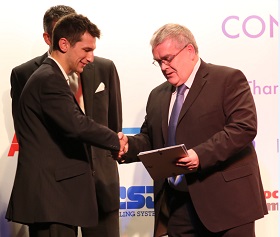
What is your current role?
I am responsible for a small team of mechanical engineers who run FEA simulations and create models of the mechanical components of the pump.
My role involves developing the mechanical processes by either driving the changes myself or overseeing them as a supervisor. Some of these projects follow the Six Sigma DMAIC (Define, Measure, Analyze, Improve, Control) methodology.
I am also responsible for the training and development of staff within my team.
Outline your career so far. Have you worked on any unusual or high profile projects?
From 2010 to 2014, I was the project lead on the cooling pump for the Cummins Hedgehog diesel project, their flagship engine, created to meet the regulatory requirements for Tier 4 emissions standards..
You were registered as an EngTech (Engineering Technician) before becoming an IEng (Incorporated Engineer)? Describe your experience of becoming an EngTech
I became EngTech registered after I had completed my apprenticeship at Gilbert Gilkes and Gordon Ltd. I have subsequently successfully gained a BEng degree in Mechanical Engineering.
What encouraged your registration as an IEng?
As IEng is a natural progression from EngTech, once I had acquired my BEng the next step for me was to apply for IEng.
Describe how you became an IEng.
When I began to consider the next stage of my professional progression, I was advised of the IEng registration by a Business Development Manager (BDM) who visited my workplace. The Institution supported me to make my application and I received financial support from my employer.
It took around 6 months, after I completed my accredited degree at Lancaster University, for me to become IEng registered; this included making the application and the interview process.
Did anything surprise you about the experience?
As I had imagined the process was more in depth than at EngTech level, however I still had to work within the word limitations set. It was also important to present my application in the first person to highlight how I had met the competences.
Once I was confident about the requirements and after receiving support from the Business Development Team I found the process was much easier.
What advice would you give someone considering professional registration as an IEng?
Being IEng registration shows your employer you have met a certain standard in engineering, it looks good to have this on your CV. The IEng registration provides you with a natural progression towards CEng status.
How has becoming an IEng benefited your career?
Being IEng registered has helped me in gaining a promotion and it is a positive contribution to my appraisals.
How does your employer benefit from you being an IEng?
Professional registration is something that customers look for in engineers and so it is helpful in attracting further business.
What are your future career goals?
Further to gaining IEng registration and a promotion at work, I would like to further my career at Gilbert Gilkes and Gordon Ltd. I would also like to progress to CEng status with the Institution. I am investigating what further learning I may need.
Find out more about becoming an Incorporated Engineer (IEng).